|
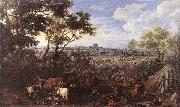 |
MEULEN, Adam Frans van der
|
|
Flemish painter (b. 1632, Bruxelles, d. 1690, Paris).
Flemish painter and draughtsman, active also in France. He was the eldest son of the seven children of Pieter van der Meulen and his second wife Marie van Steen Wegen. He went to study with Pieter Snayers, court painter in Brussels, on 18 May 1646, and in 1651 he became a master in the Brussels painters' guild. Probably soon after he married Catherina Huseweel. During the first 15 years of his career, the so-called Brussels period, he painted small-scale genre and history scenes with political and military events in the Baroque style of Sebastiaen Vrancx, Pieter Snayers and Jan Breughel the elder. Typical examples are a Cavalry Battle (1653; Geneva, Mus. A. & Hist.), a Ceremonial Entry into Brussels (1659; Kassel, Gemeldegal.), a General on Campaign (1660; Madrid, Prado) and a Hunting Scene |
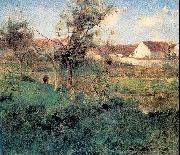 |
Metcalf, Willard Leroy
|
|
American Impressionist Painter, 1858-1925
American painter and illustrator. His formal education was limited, and at 17 he was apprenticed to the painter George Loring Brown of Boston. He was one of the first scholarship students admitted to the school of art sponsored by the Museum of Fine Arts, Boston, and took classes there in 1877 and 1878. After spending several years illustrating magazine articles on the Zuni Indians of New Mexico, he decided to study abroad and in 1883 left for Paris. There he studied at the Acad?mie Julian under Jules Lefebvre and Gustave Boulanger. During the five years he spent in France he became intimately acquainted with the countryside around the villages of Grez-sur-Loing and Giverny. He returned to America in 1888 |
 |
Merson, Luc-Olivier
|
|
French Painter, 1846-1920
French painter and illustrator. He was the son of the painter and art critic Charles-Olivier Merson (1822-1902) and trained initially at the Ecole de Dessin in Paris under Gustave Adolphe Chassevent (1818-1901) and then at the Ecole des Beaux-Arts under Isidore-Alexandre-Augustin Pils. He made his d?but at the Salon in 1867 and won the Grand Prix de Rome in 1869 with the melodramatic work, the Soldier of Marathon (1869; Paris, Ecole N. Sup. B.-A.). As a prizewinner he then spent five years in Italy, where he was impressed and influenced by the works of the Italian Primitives, as is apparent in such works as St Edmund, King and Martyr (1871; Troyes, Mus. B.-A. & Arch?ol.), with its muted colours and rigid composition. In the Salon of 1875 he exhibited Sacrifice for the Country, St Michael, which had been commissioned as a design for a Gobelins tapestry for the Salle des Ev?ques in the Panth?on, Paris. Soon afterwards he was chosen to decorate the Galerie de St Louis in the Palais de Justice, Paris, with scenes from the life of Louis IX. This resulted in two large works, Louis Opening the Doors of the Gaols on his Accession and Louis Condemning Sire Enguerrand de Coucy (both 1877). He also used historical, often religious, subjects for his smaller-scale works, as in St Francis of Assisi Preaching to the Fish (1880; Nantes, Mus. B.-A.). |
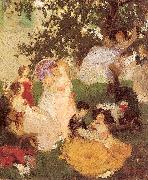 |
Merse, Pal Szinyei
|
|
Hungarian Painter, 1845-1920
was a Hungarian painter and politician. Born in Szinye??jfalu, Hungary (today Chminianska Nov?? Ves, Slovakia), he learned painting at the Academy of Fine Arts, Munich under Karl von Piloty. He was a friend of Wilhelm Leibl and Hans Makart. His are some of the earliest works of Impressionism in Hungary and Central Europe. At the 1873 World's Fair in Vienna he won a medal with his painting Bath House. Szinyei was also an active politician. He was elected to the parliament of Hungary where he fought for the modernization of art education. He died in February 2, 1920, just four month and two days before the Trianon treaty, in Jarovnice |
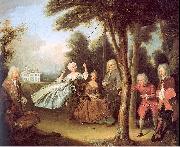 |
Mercier, Philippe
|
|
French Painter, ca.1689-1760
was a French painter and etcher, who lived principally and was active in England. He was born in Berlin of French extraction, the son of a Huguenot tapestry-worker. He studied painting at the Akademie der Wissenschaften of Berlin[1] and later under Antoine Pesne, who had arrived in Berlin in 1710. Later, he traveled in Italy and France before arriving in London??"recommended by the Court at Hannover"??probably in 1716. He married in London in 1719 and lived in Leicester Fields. He was appointed principal painter and librarian to the Prince and Princess of Wales at their independent establishment in Leicester Fields, and while he was in favor he painted various portraits of the Royalties, and no doubt many of the nobility and gentry. Of the Royal portraits, those of the Prince of Wales and of his three sisters, painted in 1728, were all engraved in mezzotint by Jean Pierre Simon, and that of the three elder children of the Prince of Wales by the John Faber Junior in 1744. This last was a typical piece of Mercier's composition, the children being made the subject of a spirited, if somewhat childish, allegory in their game of play. Prince George is represented with a firelock on his shoulder, teaching a dog his drill |
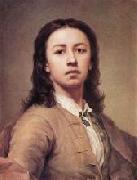 |
MENGS, Anton Raphael
|
|
German Neoclassical Painter, 1728-1779
Painter and writer, brother of Theresia Concordia Mengs. His early career was at the Dresden court; thereafter he worked principally in Rome and Madrid, notably on the frescoes at the Villa Albani and the Palacio Real respectively. As an early exponent of Neo-classicism he produced some impressive classical and religious scenes, though he was most accomplished as a portrait painter. Under the influence of Johann Joachim Winckelmann he also wrote some theoretical works, of which the most important is the Gedanken ber die Schenheit und ber den Geschmack in der Malerey (1762). Although acclaimed during his lifetime
|
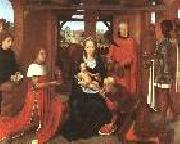 |
MEMLING, Hans
|
|
Netherlandish Northern Renaissance Painter, ca.1435-1494
South Netherlandish painter of German origin. Together with Dieric Bouts I and Hugo van der Goes, he was one of the most important exponents of the new artistic developments that flourished in the southern Netherlands in the 15th century in the wake of Jan van Eyck, the Master of Fl?malle and Rogier van der Weyden. Their principal innovation was to apply optic realism to devotional or mystical subjects. Although Memling lived in the turbulent period of transition from the Burgundian ruling house to that of the Habsburgs, little of this is evident in his work. His commissions were almost exclusively from rich burghers in Bruges (bankers, merchants and politicians) or churchmen and the occasional aristocrat. Often they were foreigners, especially Italians, who had political or financial connections with the town, whose central economic position was to last only a few decades longer. They had Memling paint their portraits, bust or full length, in devotional paintings or on altarpieces for their chapel in Bruges or back home. He seems not to have received official commissions (from the town council or court). An exceptional proportion of this oeuvre has survived. Besides about 20 altarpieces, often in several panels and of considerable size, |
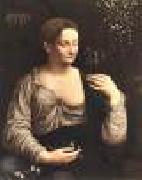 |
MELZI, Francesco
|
|
Italian Painter, 1493-1570
Italian painter and draughtsman. Belonging to a noble Lombard family, he began to attend the workshop of Leonardo da Vinci around 1508, during Leonardo's second visit to Milan. From that time on he was always associated with Leonardo, whose favourite pupil he became: he followed Leonardo to Rome in 1513 and moved with him to France in 1515, staying with him until his death in 1519. |
 |
Melozzo da Forli
|
|
1438-1494
Italian
Melozzo da Forli Location
Melozzo came, it is supposed, of a wealthy family named Ambrosi from Forl??. Nothing is known about his early years, and it is only a hypothesis that he formed at the Forlivese school of art, then ruled by Ansuino da Forl??, for they were both influenced by the Mantegna manner.
It has been said that he became a journeyman and color-grinder to some of the best masters, in order to prosecute his studies; this lacks confirmation. His presence his first mentioned in his birthplace in 1460 and again in 1464. Around this period, together with Antoniazzo Romano, frescoed the Bessarione chapel in the basilica dei Santi Apostoli in Rome. Melozzo presumably moved to in Urbino between 1465 and 1475: here he met the highly theoretical and mathematical Piero della Francesca, who profoundly influenced the Melozzo style and use of perspective. He should have also studied the architectures by Bramante and other Flemish painters then working for the duke Federico da Montefeltro: perhaps Melozzo worked with Justus of Ghent and Pedro Berruguete to the decoration of the studiolo of the famous Ducal Palace of the city.
In 1475 Melozzo transferred to Rome, though some authorities claim his presence in Rome ten (or five) years earlier to work in the Basilica di San Marco. In 1477 he finished his first major work in the new seat, a fresco now transferred to canvas and placed in the Pinacoteca Vaticana, representing the appointment of Bartolomeo Platina by Sixtus IV as librarian of the restored Vatican Library. In 1478 he was one of the original members of the academy of St Luke, founded by Sixtus IV to unite the main painters working in the city.
About 1480 Melozzo was commissioned by Pietro Riario to paint the vault of the apse in the basilica dei Santi Apostoli in Rome, his subject being the Ascension. The figure of Christ is so boldly and effectively foreshortened that it seems to burst through the vaulting; this fresco was taken down in 1711, and the figure of Christ is now in the Quirinal Palace; while some of the other portions, almost Raphaelesque in merit, are in the sacristy of St Peter: a hall in the Vatican Museums is designed for angels and apostles by Melozzo taken down the same fresco. Another work of the Roman period is an Annunciation that can still be seen in the Pantheon.
Melozzo last work in Rome is a chapel, now destroyed, in the church of Santa Maria in Trastevere. After the death of Sixtus IV in 1484 he moved from Rome to Loreto. Here he painted the fresco in the cupola of San Marco sacristy in the basilica della Santa Casa, commissioned by cardinal Girolamo Basso della Rovere. It is one of the first examples of a cupola decorated both with architectures and figures, with a profound influence from the Camera Picta by Mantegna.
In 1489 Melozzo returned in Rome. In this second period he probably drew some cartoons for the mosaics of Jesus blessing in the St. Helen chapel of the basilica of Santa Croce in Gerusalemme.
Pope Sixtus IV appoints Bartolomeo Platina prefect of the Vatican Library, c. 1477 (fresco) (Vatican Museums)Melozzo also painted the cupola of the Capuchin church at Forl??, destroyed in 1651; and it has been said that he executed at Urbino some of the portraits of great men (Plato, Dante, Sixtus IV, etc.) which are now divided between the Barberini Palace and the Campana collection in Paris. In 1493 he worked to some ceilings of the Palazzo Comunale of Ancona, which have gone lost. Eventually Melozzo moved to Forl??, where, together with his pupil Marco Palmezzano, decorated the Feo Chapel in the church of San Biagio, which was destroyed during World War II. The Pinacoteca of Forl?? houses a fresco by Melozzo, termed the Pestapepe, or Pepper-grinder, originally painted as a grocer sign; it is an energetic specimen of rather coarse realism, now much damaged. It is the only non-religious subject by Melozzo. |
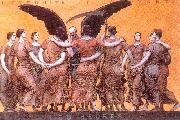 |
Mellery, Xavier
|
|
Belgian Symbolist Painter, 1845-1921
Belgian painter, decorative artist and draughtsman. A gardener's son, he was brought up in a quiet suburb of Brussels, bordering the Parc Royal. He studied under the decorative artist Charles Albert (1821-89) and then, between 1860 and 1867, took a course in decorative design at the Brussels Acad?mie. In 1864 he joined the studio of Jean-Fran?ois Portaels to learn the techniques of modelling, painting from life and history painting. Having won the Belgian Prix de Rome in 1870, he travelled to Italy, where he was inspired by the work of Mantegna. His early work treated the working lives of the Belgian poor in a social realist manner influenced by Charles de Groux |
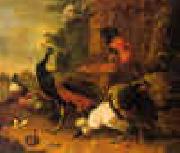 |
Melchior de Hondecoeter
|
|
1635-1695
Dutch
Melchior de Hondecoeter Gallery
Melchior d'Hondecoeter (c. 1636 ?C April 3, 1695), Dutch animalier painter, was born at Utrecht, and died in Amsterdam. After the start of his career, he painted virtually exclusively bird subjects, usually exotic or game, in a park-like landscapes.
Being the grandson of Gillis d'Hondecoeter and son of Gijsbert d'Hondecoeter, as well as nephew of Jan Baptist Weenix, he was brought up by the last to the profession of painting, when his father died. Of Weenix we know that he married Gilles daughter Josina in 1638. Melchior was, therefore, also related to Jan Weenix. The latter told Arnold Houbraken, in his youth Melchior was extremely religious, praying very loud, so his mother and uncle doubted if they would have him trained as a painter.
In 1659 he was working in the Hague and became a member of the painters' academy at the Hague. In 1663 Hondecoeter married Susanne Tradel in Amsterdam. While she was captious and having her sisters living in their house, Hondecoeter spent much time in his garden or drinking in the tavern in the Jordaan. On the Lauriergracht, where he used to live, he was surrounded by art dealers and various painters. Later he moved to a house on Prinsengracht. In 1686 he bought a small countryhouse in Vreeland. Hondecoeter died in the house of his daughter Isabel in Warmoesstraat but was buried in Westerkerk near his house. His inventory lists a small gallow, to keep birds in the right position, and several paintings of Frans Snyders.
Melchior began his career with a different speciality from that by which he is usually known. Mr de Stuers affirms that he produced sea-pieces. One of his earliest works is a "Tub with Fish," dated 1655, in the gallery of Brunswick. But Melchior soon abandoned fish for fowl. He acquired celebrity as a painter of birds only, which he represented not exclusively, like Johannes Fyt, as the gamekeeper's perquisite after a day's shooting, or stock of a poulterer's shop, but as living beings with passions, joys, fears and quarrels, to which naturalists will tell us that birds are subject. Without the brilliant tone and high finish of Fyt, his Dutch rival's birds are full of action; and, as Burger truly says, "Hondecoeter displays the maternity of the hen with as much tenderness and feeling as Raphael the maternity of Madonnas." |
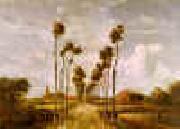 |
Meindert Hobbema
|
|
1638-1709
Dutch
Meindert Hobbema Galleries
In the exercise of his craft Hobbema was patient beyond all conception. It is doubtful whether any one ever so completely mastered as he did the still life of woods and hedges, or mills and pools. Nor can we believe that he obtained this mastery otherwise than by constantly dwelling in the same neighbourhood, say in Guelders or on the Dutch Westphalian border, where day after day he might study the branching and foliage of trees and underwood embowering cottages and mills, under every variety of light, in every shade of transparency, in all changes produced by the seasons. Though his landscapes are severely and moderately toned, generally in an olive key, and often attuned to a puritanical grey or russet, they surprise us, not only by the variety of their leafage, but by the finish of their detail as well as the boldness of their touch. With astonishing subtlety light is shown penetrating cloud, and illuminating, sometimes transiently, sometimes steadily, different portions of the ground, shining through leaves upon other leaves, and multiplying in an endless way the transparency of the picture. If the chance be given him he mirrors all these things in the still pool near a cottage, the reaches of a sluggish river, or the swirl of the stream that feeds a busy mill. The same spot will furnish him with several pictures. One mill gives him repeated opportunities of charming our eye; and this wonderful artist, who is only second to Ruisdael because he had not Ruisdael's versatility and did not extend his study equally to downs and rocky eminences, or torrents and estuaries - this is the man who lived penuriously, died poor, and left no trace in the artistic annals of his country. It has been said that Hobbema did not paint his own figures, but transferred that duty to Adriaen van de Velde, Lingelbach, Barendt Gael, and Abraham Storck. As to this much is conjecture. |
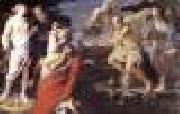 |
MEI, Bernardino
|
|
Italian painter, Roman school (b. 1612, Siena, d. 1676, Roma)
Italian painter, draughtsman and printmaker. His early art drew on a variety of sources, which included the naturalism of Rutilio Manetti and Francesco Rustici, the descriptive realism of the engraver Giuliano Periccioli (d 1646) and the Baroque of Raffaelle Vanni. Mei's interests even embraced 16th-century Sienese art. This stylistic variety is evident in his first known works, such as a bier (Casole d'Elsa, Collegiata), three signed miniatures in the Libro dei leoni (1634; Siena, Pal. Piccolomini, Archv Stato) and frescoes of scenes from the Life of St Bernard (1639; Siena, oratory of S Bernardino). His experimental approach is also displayed in such works as the Annunciation (Siena, Mus. Semin. Montarioso), which may be dated between the mid-1630s and the early 1640s. Mei's early maturity is marked by a conscious return to the naturalism of Manetti, enriched with a Baroque pathos and soft, fluid brushwork, as in the St Peter in Prison Awoken by the Angel and St Peter Freed by the Angel (both Siena; Conservatori Femminili Riuniti). His interest in both naturalism and the Baroque made him responsive to the art of Mattia Preti, possibly seen in Rome, as in the Beheading of St John the Baptist (1647; Siena, oratory of S Giovannino in Pantaneto) and the frescoes of scenes from the Life of St Roch and Life of St Job (1648; Siena, S Rocco), |
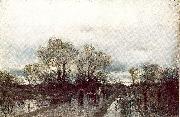 |
Mednyanszky, Laszlo
|
|
Hungarian, 1852-1919
Ladislaus Josephus Balthasar Eustachius Mednyenszky was a Hungarian painter in the Impressionist tradition. Despite an aristocratic background, he spent most of his life moving around Europe working as an artist. Mednyenszky spent considerable periods in seclusion but mingled with people across society - in the aristocracy, art world, peasantry and army - many of whom became the subjects of his paintings. His most important works depict scenes of nature and poor, working people, particularly from his home region in Upper Hungary. Medny nszky was born in Beck, the Kingdom of Hungary (now Beckov in Slovakia), to Eduard Mednyenszky and Maria Anna Mednyenszky, (nee Szirmay) both from landowning families. Mednyenszky's family moved in 1861 to the chateau of his grandfather, Baltazer Szirmay, at Nagyőr (Strežky), near Szepesbela (Spišsk Bele) in north-eastern Hungary. This was to be the setting for many of his works. Medny nszky met the Austrian artist Thomas Ender in 1863 when Ender visited the chateau at Nagyőr. Ender took an interest in Mednyenszky's early efforts at drawing, lending his assistance to improve Mednyenszky's skills. Mednyenszky attended a grammar school in K??smerk (Kežmarok), near his home, then attended the Akademie der Bildenden Kenste (Academy of Fine Arts) in Munich in 1872 - 1873. Dissatisfied in Munich, he moved to Paris to attend the École des Beaux-Arts. After the death of his professor, Isidore-Alexandre Augustin Pils, in 1875, Mednyenszky left the École and began practicing independently from Montmartre. Mednyenszky returned to Nagyőr after 1877 to continue painting, and subsequently travelled widely in Europe, between his childhood homes in Upper Hungary and Budapest, Vienna, Paris and beyond. Mednyenszky visited the Szolnok artists' colony in the autumn of 1877 and Italy in 1878. His mother died in 1883, after which he lived in seclusion in Nagyőr. He returned to Nagyőr in 1887 to help deal with an outbreak of cholera but soon fell ill himself, with pneumonia. He spent much of 1889-1892 in Paris and returned regularly to Nagyőr until 1900. |
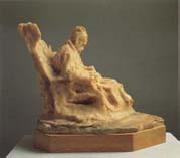 |
Medardo Rosso
|
|
1858 Turin-1928 Milan,was an Italian sculptor. He is thought to have developed the Post Impressionism style in sculpture along with Auguste Rodin. Medardo Rosso was born in Turin, Italy, in 1858, the son of the city stationmaster. Later his family mover to Milano (Milan). As a child Rosso played hooky from school to visit a monument mason who taught him to handle a chisel and hammer. This distressed and angered his parents. At the age of 23, after a period of military service as unsatisfactory as his home life, he enrolled at the Berea Academy in Milano, where he learned to draw classical statues and copy them in gesso. But academic art appeared to him entirely artificial, unrelated to the world around him. Before long he helped to organize the Berea students into demanding life models for the drawing classes. As a result of his revolutionary behavior he was expelled from the school. He moved to Rome, where he lived in great poverty, sleeping among the ruins of the Colosseum. To the end of his life Rosso battled unremittingly against the academicians. What absorbed, even obsessed, him was the problem of interpreting life itself. In 1882, some time before he saw any Impressionist paintings, he produced his fully impressionistic sculptures, The Street Singer and Lovers under the Lamplight. In 1884 some friends arranged an exhibition for him in Paris, where he lived for a time in a cheap boarding-house. |
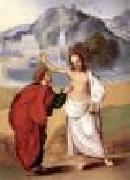 |
MAZZOLINO, Ludovico
|
|
Italian Painter, 1480-1528
.Italian painter. He may have served an apprenticeship with Ercole de' Roberti (Morelli) before he left Ferrara to study in Bologna with Lorenzo Costa (i). The earliest surviving documentation is from 20 May 1504, when he received a first payment for frescoes (destr. 1604) in eight chapels in S Maria degli Angeli, Ferrara, commissioned by Ercole I d'Este, Duke of Ferrara and Modena. Between 1505 and 1507 he was paid for works, presumably decorative, in the Este guardaroba and the camerini of the Duchessa Lucrezia Borgia in Ferrara Castle (untraced). His first surviving dated painting is the triptych of the Virgin and Child with SS Anthony and Mary Magdalene |
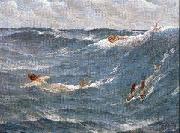 |
Maynard, George Willoughby
|
|
American, 1843-1923
American figure, marine, and mural painter, b. Washington, D.C., studied at the National Academy of Design and in Florence and Antwerp. Maynard created decorations for the Library of Congress and the old Metropolitan Opera House, New York City. |
 |
Maxime Maufra
|
|
was a French landscape and marine painter, etcher and lithographer.
Maufra first began painting at 18. He was encouraged to do so by two artists from Nantes: the brothers Leduc. However, he didnet fully embrace his painting career right away. Being a businessman, he only painted on his spare time from 1884 to 1890. During this time, Maufra discovered the work of the Impressionists and was able to display his works at the Paris Salon of 1886. In 1890, Maufra decided to give up commerce and to become a full-time painter. He left Nantes for Brittany, where he was able to meet Paul Gauguin and Paul Serusier. Maufra had his first solo exhibition in Paris in 1894, at Le Barc de Toutteville. Returning from Brittany, Maufra was the first painter to take up residence in The Bateau-Lavoir, a famous Parisian residence for artists.
In his paintings, Maufra sometimes quoted the pointillisit technique of Pissarro or Sisley, and also took from the strong colors and powerful drawing of the Pont Aven school. However, Maufra stayed an independent artist his all life through, and dedicated his art to recording the beauty of nature.
|
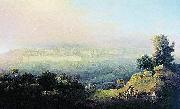 |
Maxim Nikiforovich Vorobiev
|
|
(1787-1855) was a Russian Romantic landscape painter.
Vorobiev was born into the family of a soldier, who on retirement became a guard in the Academy of Arts in St. Petersburg. There, Maxim was admitted in 1798 where he initially studied architecture but graduated as a landscape painter in 1809.
|
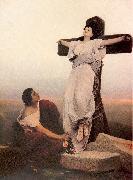 |
Max, Gabriel Cornelius von
|
|
Czechoslovakian, 1840-1915
Painter, illustrator and teacher, nephew of (1) Emanuel Max. He studied at the Academy of Fine Arts, Prague (1855-8), and the Akademie der Bildenden K?nste, Vienna (1858-61), and under Karl Theodor von Piloty at the Akademie der Bildenden K?nste, Munich (1863/4-7). He settled in Munich, where he opened a private school of painting in 1869. His paintings and book illustrations of the second half of the 1860s show an affinity with the late Romanticist movement. He illustrated works of German literature by Wieland, Lenau and Schiller, as well as producing illustrations for Goethe's Faust (1867-8; Prague, N.G., Kinsky Palace). As well as literary and even musical sources, religious themes frequently occur in his work, including his first great success, the Crucifixion of St Julie (1867; ex-Sotheby's, London, 1976). In numerous female figures and portraits Max explored the tension between the inner state and the charm of the physical appearance or surroundings of his subjects. His interest in the artistic perception of relationships between physical reality and the spiritual world led him to a study of anthropology and contemporary occultism and mysticism, as in his portraits of the Seer of Prevorst |
 |
Max Uth
|
|
painted Landsitz in der Mark in 1900 |
 |
Max Slevogt
|
|
German Impressionist Painter, 1868-1932
German painter, printmaker and illustrator. His father, adjutant and friend of the future Prince Regent, Luitpold (1821-1912), died when Slevogt was just two years old. His mother moved to Werzburg, where he spent his schooldays. Even in his childhood and adolescence, family connections brought Slevogt to Pfalz, to an aunt in Landau and to the Finkler family in Neukastel. Initially he had planned to become a musician, but he began to study painting at the Akademie der Bildenden Kenste in Munich in 1885. His fellow students included Gabriel von Hackl (1843-1926), Karl Raupp (1837-1918), Ludwig Herterich (1856-1932) and Wilhelm von Diez (1839-1907). In 1889 he spent a term at the Academie Julian in Paris. At that time Impressionism had very little effect on him. Following a trip to Italy in 1890 with the painter Robert Breyer (1866-1941) who had befriended him at the Akademie, he began to work independently as a painter in Munich. In 1893 he participated in the first exhibition of the newly founded Munich Secession, exhibiting Wrestling School (1893; Edenkoben, Schloss Villa Ludwigshehe); the judges wanted to refuse this painting as immoral since its entwined and naked men caused offence. In the following years his paintings often appeared harsh and non-academic to conservative Munich circles. At this time Slevogt also made contributions to the journals Jugend and Simplizissimus, which were significant in the development of his graphic work. |
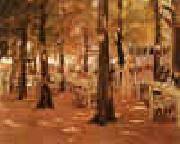 |
Max Liebermann
|
|
German Impressionist Painter, 1847-1935
Max Liebermann (July 20 1847 ?C February 8 1935) was a German painter and printmaker in etching and lithography.
The son of a Jewish businessman from Berlin, Liebermann first studied law and philosophy at the University of Berlin, but later studied painting and drawing in Weimar in 1869, in Paris in 1872, and in the Netherlands in 1876-77. During the Franco-Prussian War (1870?C71), Liebermann served as a medic with the Order of St. John near Metz. After living and working for some time in Munich, he finally returned to Berlin in 1884, where he remained for the rest of his life. He was married in 1884 to Martha Liebermann (1857-1943, see portrait by Anders Zorn).
Together with Lovis Corinth and Max Slevogt, Liebermann became an exponent of German Impressionism. He used his own inherited wealth to assemble an impressive collection of French Impressionist works. He later chose scenes of the bourgeoisie, as well as aspects of his garden near Lake Wannsee, as motifs for his paintings. In Berlin, he became a famous painter of portraits; his work is especially close in spirit to Édouard Manet.
"Boys Bathing" Neue PinakothekFrom 1899 to 1911 he led the premier avant-garde formation in Germany, the Berliner Secession. Beginning in 1920 he was president of the Prussian Academy of Arts. In 1933 he resigned when the academy decided to no longer exhibit works by Jewish artists. While watching the Nazis celebrate their victory by marching through the Brandenburg Gate, Liebermann was reported to have commented: "Ich kann gar nicht so viel fressen, wie ich kotzen möchte" ("I could not eat as much as I would like to vomit.")
On 30 April 2006, the Max Liebermann Society opened a permanent museum in the Liebermann family's villa in Berlin-Wannsee. The artist's wife, Martha Liebermann, was forced to sell the building in 1940. In 1943 she committed suicide in the family home, Haus Liebermann, hours before police came to deport her to Theresienstadt concentration camp. |
 |
Max Koch
|
|
(born July 17, 1854 - April 1, 1925) was a German-born Australian botanical collector.
Born in Berlin, Koch was apprenticed to a merchant's office, but, not liking the work, joined the crew of a Glasgow-based sailing ship at Bremerhaven. He left it at Port Augusta, South Australia in April 1878, taking work at a wheat farm. Later he moved to Mount Lyndhurst sheep station, where he remained for many years. Around 1896 he began serious botanical collecting.
Koch visited Germany around 1902-1903, then returned to Australia, and in 1904 moved to the extreme south-west of Western Australia, where he spent the next 17 years working in the timber industry. By that time he had a large family, and he supplemented his income by plant specimens, and, in his later years, seed. He died at Pemberton, Western Australia in 1925
|
 |
Max Klinger
|
|
German Symbolist Painter and Sculptor, 1857-1920
German painter, printmaker, sculptor and writer. He was one of the most versatile German artistic personalities of the turn of the 20th century and was especially celebrated for his cycles of prints, which were influential. |
 |
Max Joseph Wagenbauer
|
|
Maximilian Joseph Wagenbauer (1775 Grafing - 1829 Munich), was a Bavarian artist.
After finishing school, Wagenbauer attended drawing classes in Munich, under Johann Jakob Dorner the Elder (1741-1813). At the turn of the 19th century he was producing mostly Neo-Classical watercolour landscapes. He served in the military from 1797 to 1801, receiving a royal artist's annuity after his service through the influence of Johann Christian von Mannlich (1741-1822), architect and general building director of the dukes of Zweibre-ken. A condition of the royal stipend was that he produce paintings. He was appointed artist to the court and cabinet in 1802 and Inspector of the Royal Paintings Gallery in 1815. Wagenbauer focused increasingly on oil painting after 1810 and enjoyed the patronage of Maximilian I Joseph of Bavaria, who in 1811 commissioned him, Cantius Dillis (1779-1856) and Johann Jakob Dorner the Younger (1775-1852) to decorate the banquet hall at Schloss Nymphenburg with large paintings of Bavarian lakes. |
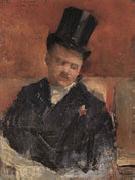 |
Max Buri
|
|
1868-1915,Swiss painter. While still at school he was given drawing lessons by Paul Volmar (1832-1906) in Berne. From 1883 he was a pupil of Fritz Schider (1846-1907) in Basle, where he became acquainted with the works of Hans Holbein the younger and Arnold B?cklin. In 1886 he went to the Akademie der Bildenden K?nste in Munich, transferring in 1887 to Simon Holl?sy painting school. After seeing the works of the French Impressionists exhibited in Munich, he moved to the Acad?mie Julian in Paris in 1889. He made several journeys to Algeria, Holland, Belgium and England, and in 1893 he returned to Munich to study under Albert von Keller. In 1898 he settled in Switzerland, living first at Lucerne, then from 1903 in Brienz, near Interlaken. About 1900, influenced by the paintings of Ferdinand Hodler, Buri moved on from his early genre pictures, which were in mawkish shades of pink in the style of Keller and H?llosy, to achieve an individual style that brought him great popularity. He established his reputation with Village Politicians (1904; Basle, Kstmus.). He painted mainly the landscape and people of the Bernese Oberland, often depicting single figures and groups in front of bare indoor walls in realistic everyday scenes. The expressiveness of the compositions is achieved by clear contours and powerful clearly differentiated surfaces in local colours. Buri works are essentially populist rather than intellectual and avoid Hodler strict parallelism and Symbolist content. |
|

